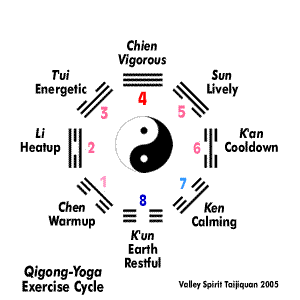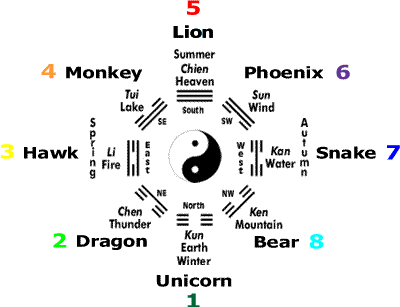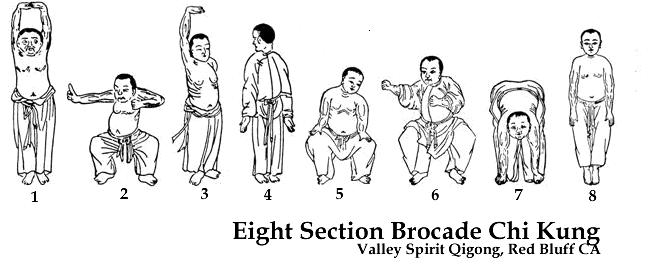Soft Qigong (Rou Gong), Inner Qigong (Nei Gong); Slow Pace, Gentle, Soft, At Ease, Relaxed (Sung), Rooted/Sunk, Yin Style
Eight Section Brocade Exercise
|
I Ch'ing Trigram
|
Parts of the Body Affected
|
| 1. Pressing Up to the Heavens with Two Hands | South, Summer Ch'ien, Qián, Heaven, Sky, Air Intense Yang Lion | Heart, Small Intestine, Stomach, Lungs (The Triple Warmer) |
| 2. Drawing the Bow and Letting the Arrow Fly | Southwest, Mid-Summer Sun, Wind Yang Phoenix | Kidneys, Spleen, Waist, Eyes, Legs |
| 4. Wise Owl Gazes Backward | West, Autumn K'an, Water Yang-Yin Snake | Lungs, Immune System, Large Intestine |
| 5. Big Bear Turns from Side to Side | Northwest, Mid-Autumn Ken, Gèn, Mountain Yin-Yang Bear | Heart, Waist, Legs |
| 3. Separating Heaven and Earth | North, Winter K'un, Earth Intense Yin Unicorn, Qilin | Spleen, Kidneys, Bladder, Pancreas |
| 8. Shaking the Body | Northeast, Mid-Winter Chen, Zhèn, Thunder Yin Dragon | Immune System, Calves, Feet |
| 6. Punching with Angry Gaze | Spring, East Li, Fire Yin-Yang Hawk, Falcon | Liver, Gallbladder, Blood, Eyes |
| 8. Touching Toes then Bending Backwards | Southeast, Mid-Spring Tui, Lake Yang-Yin Monkey | Kidneys, Waist, Legs, Back |
The above three charts were proposed in 2005 by Mike Garofalo, in his webpage on the Eight Section Brocade. See also Mike's webpage on the Eight Trigrams.
In 2014, Christina Barea-Young and Peyton Young provided another set of associations for the Eight Section Brocade movements with the Eight Trigrams in Qi Magazine (Volume 24, No. 2, 2014, p. 48).
I find these kinds of correlations, associations, and relational charts quite inconsistent between various authors. Yoga, Western Esoteric Magic, and Qigong have many of the same kind of charts and tables of correlations; again, with considerable inconsistency between various "masters." Other than the "traditions of specific esoteric schools", I find the associations rather arbitrary and fanciful, primarily aids to remembering clusters of ideas, poetic devices, magical-metaphysical lore, and lacking in much pragmatic-scientific meaningfulness. Contrast these charming and pre-scientific tables with the modern and justifiably famous "Periodic Table of the Elements" for a real lesson in an objective and empirical approach to understanding the world. Nevertheless, these clusters of ideas may stimulate the imagination, and are fun for playing thought games.
"The names of the 108 Forms are each symbolic and signify concepts removed from the literal physicality of the object - horse, tiger, bird, and so forth. Each name has its separate allusion, and metaphorically may connote an aspiration, a philosophical attitude towards self and conduct, a turn of mind, a sense of being, some thought about life and spirit. The true meanings are revealed when the T'ai-Chi Ch'uan exponent has advanced to that stage of experience comprehension where he can utilize the implication of the philosophical intentions, and where the symbols can be part of his growing consciousness. This happens only when the mind and body have "changed" and absorbed the reasons for mental, emotional, and physical unity."
- Sophia Delza, The T'ai Chi Ch'uan Experience, 1996, p. 24
The above long chart is more readable on my Eight Section Brocade webpage, 441 KB, last updated on June 20, 2014.



No comments:
Post a Comment